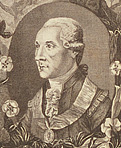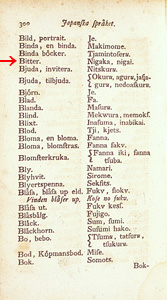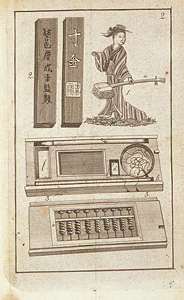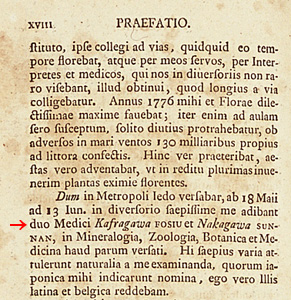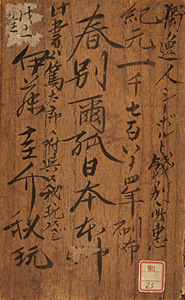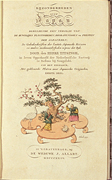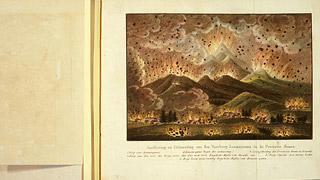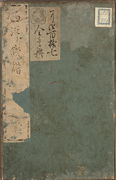This is an agricultural encyclopedia that was compiled at the order of Lord Shimazu Shigehide (1745-1833) of the Satsuma Domain. The compilation began in 1793. At first 100 volumes with such sections as agriculture, grains, vegetables, medicinal herbs, seafood, and birds and beasts were due to be published, but the woodblocks were lost in two fires and the poor financial state of the domain resulted in only the first 3 pts. (30 volumes) being published. The Dutch translation of the item names is included. This work consists of a special multi-color printing and a black ink printing, but this book is the former and has beautiful illustrations. Shigehide was known to be fond of learning and he directly associated with I. Titsingh and P. F. von Siebold.
Home | Part 2: View by Topics | 1. Study of Japan by Foreigners Coming to Japan (2)
Part 2: View by Topics
1. Study of Japan by Foreigners Coming to Japan (2)
C. P. Thunberg
|
Carl Peter Thunberg (1743-1828) Carl Peter Thunberg was a Swedish physician and botanist. He studied under C. von Linne, who established the system of plant taxonomy. He came to Japan in 1775 as a physician for the Dutch East India Company (V.O.C.). He accompanied the chief of the Dutch factory on his journey to the Edo court and engaged in exchange with Dutch studies scholars Katsuragawa Hoshu and Nakagawa Jun'an among others. He left Japan in 1776. After returning, he became a professor and dean of Uppsala University. This portrait of C. P. Thunberg is taken from the French language version Voyages au Japon (1796) of his book of travels.. |
|
Thunberg, C. P.: Resa uti Europa, Africa, Asia, forrattad aren 1770-1779.
Upsala: J. Edman, 1788-93. 4 v. <WB26-15>
This book is a Swedish language travel narrative written after Thunberg returned from Japan. Of the four volumes in total, Volume 3 and the beginning of Volume 4 are about Japan. This was later translated into French and other languages. This image of a list of Japanese vocabulary is particularly interesting, because it also shows the Kyushu dialect, as in 'nigaka, nigai' for 'bitter'. This illustration shows a Japanese woman in casual wear with a shamisen and a small box containing Chinese ink, an abacus, and a writing brush.
Thunberg, C. P.: Flora Iaponica.
Lipsiae: I. G. Mulleriano, 1784. 1 v. <別-25>
This book is the first attempt to classify Japanese flora using Linnaean taxonomy. C. P. Thunberg used the plants personally collected in Japan as well as the herbals of E. Kaempfer and of Japan as references. The names of Katsuragawa Hoshu (see next entry) and Nakagawa Jun'an, with whom C. P. Thunberg associated, are mentioned in the preface. On the top of book box, it is written in Chinese ink that it was given as a present by P. F. von Siebold to Ito Keisuke, who was returning to Owari after studying in Nagasaki (Refer to (P. F. von Siebold)), and was then handed down to Keisuke's grandson, Tokutaro. Keisuke wrote Taisei honzo meiso based on this book. Somoku zusetsu by Iinuma Yokusai was the first in Japan to employ the Linnaean taxonomy. Belonged to the Ito Collection (Japanese).
Ezo somoku zu.
Illustrated by Kobayashi Toyoaki. Copied by Katsuragawa Hoshu. Ms. 1 v. <寄別11-2>
This is a copy of Ezo somoku zu that was transcribed by Katsuragawa Hoshu and bears the seal of ownership and notes of Hoshu. The original book contains the sketches of plants made by Shogunate government official Kobayashi Toyoaki while he was dispatched to Ezo (Hokkaido), and was presented to the Shogunate government. The detailed drawings show the high level of Hoshu's artistic skill. The National Diet Library also possesses a copy of Ezo somoku zu that was transcribed by Kurimoto Zuiken from a copy owned by Hotta Masaatsu. Katsuragawa Hoshu (1751-1809) was a physician who served the Shogunate, and also was involved in the translation of Anatomische Tabellen. He made an effort to gain new knowledge, such as by talking with C. P. Thunberg and others in the retinue of the chief of the Dutch factory when in Edo visiting the court. The results of that effort can also be seen in Komo zatsuwa by Hoshu's brother Morishima Churyo. Belonged the Ito Collection (Japanese)..
Titsingh
Isaac Titsingh ( 1745-1812)
I. Titsingh was born in Amsterdam. He received a medical education and worked for the Dutch East India Company (V.O.C.) and in 1779, was sent to Japan as the chief of the Dutch factory and stayed there for 3 terms totaling 3 years 8 months. He journeyed to the court in Edo in 1780 and 1782. He had broad exchanges with domain lords including Shimazu Shigehide and Kutsuki Masatsuna, Dutch interpreters such as Yoshio Kogyu, and Dutch studies scholars like Katsuragawa Hoshu and Nakagawa Jun'an, and he continued his correspondence with these people even after leaving Japan.
Titsingh, I.: Bijzonderheden over Japan.
's Gravenhage: W. J. Allart, 1824-25. 2 v. <GB349-4>
This is the Dutch language version of I. Titsingh's Illustrations of Japan. F. Shoberl translated the French Ceremonies usitees au Japon pour les mariages et les funerailles (1819) and Memoires et anecdotes sur la dynastie regnante des djogouns, souverains du Japon (1820) into English and these were published in 1822 as Illustrations of Japan, and which were then translated into Dutch two years later. This work is replete with current affairs, such as actions of the Tanuma Administration and the eruption of Mt. Asama in 1783.
Seiyo senpu.
By Kutsuki Masatsuna. Edited by Shoen Shujin. Toto: Matsumoto Heisuke, etc., 1787. 1 v. <191-326>
Kutsuki Masatsuna (1750-1802) was the lord of Fukuchiyama Domain. He studied Dutch studies under Maeno Ryotaku and associated with the Dutch during their stays in Edo to appear in court and with the Nagasaki Dutch interpreters. This book explains the currencies used in the European states and their colonies, but this is also a book that uses the currencies to introduce foreign affairs. The image is of the Netherlands section and says, "The Dutch come to Japan and so the Dutch currency can easily be obtained." There is also a letter in Dutch that Kutsuki sent to I. Titsingh asking him to send European currency. This book was belonged to Onoya Sohachi (Daiso), a book lender in Nagoya.
Navigation
-

-

-
Study of Japan by
Foreigners Coming to
Japan-
Study of Japan by
Foreigners Coming to
Japan (1) -
Study of Japan by
Foreigners Coming to
Japan (2) -
Study of Japan by
Foreigners Coming to
Japan (3)
-
Study of Japan by
-
Activities of Dutch Studies
Scholars -
Studying the Dutch
Language -
Receiving Knowledge form
Overseas -
Acceptance of Western
Military Science at the
End of the Edo Period -
Students Studying in the
Netherlands at the End of
the Edo Period
-
Study of Japan by
Copyright © 2009 National Diet Library. Japan. All Rights Reserved

